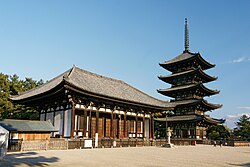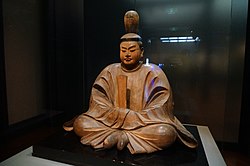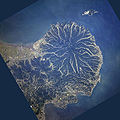kami. Unlike a jingū-ji, a miyadera had no priestly clan performing kami rituals in a separate shrine. Also, unlike those of a jingū-ji, monks at a miyadera...
14 KB (1,739 words) - 15:00, 4 August 2024
Kōfuku-ji (興福寺, Kōfuku-ji) is a Buddhist temple that was once one of the powerful Seven Great Temples in the city of Nara, Japan. The temple is the national...
13 KB (959 words) - 01:00, 19 March 2025
site of nature worship. Seiganto-ji, part of the Kumano Sanzan shrine complex, is one of the few remaining jingū-ji or shrine temples following the forcible...
8 KB (893 words) - 00:48, 27 March 2024
believed to be the first shrine-temple (jingū-ji) ever. The resulting mixed complex, called Usa Hachimangu-ji (宇佐八幡宮寺, Usa Hachiman Shrine Temple), lasted...
17 KB (1,643 words) - 12:34, 23 November 2024
Emperor. This is the case for, both, Ise Jingū and Meiji Jingū. Jingū alone, however, only refers to Ise Jingū, whose official name is just that. It is...
86 KB (9,566 words) - 08:30, 31 March 2025
was made in the 8th century during the Nara period founding so-called jingū-ji (神宮寺), that is shrine-temples, complexes comprising both a shrine and a...
24 KB (2,856 words) - 21:31, 30 January 2025
Gakuen-ji (鰐淵寺) is a Buddhist temple located in the Besshō neighborhood of the city of Izumo, Shimane Prefecture, Japan. The temple's full name is Uryōzan...
7 KB (781 words) - 11:00, 22 November 2024
transformed into an origin legend of Daigorin-ji (大御輪寺, also Ōmiwa-dera), the Buddhist temple (jingū-ji) associated with Ōmiwa Shrine during the medieval...
29 KB (3,203 words) - 05:37, 19 December 2024
Buddhist sub-temples. If a shrine housed a Buddhist temple, it was called a jingū-ji (神宮寺, lit. shrine temple). Analogously, temples all over Japan used to...
50 KB (5,745 words) - 00:12, 24 January 2025
the former Mirokuji, a Buddhist temple once connected to the shrine as a jingū-ji. Usuki Stone Buddhas: Approximately 60 cliff carvings of Buddha that were...
51 KB (5,432 words) - 05:49, 17 April 2025
Gokoku-ji (護国寺, "Protection of the Nation Temple") is a Shingon Buddhist temple in Naha, Okinawa. Established in 1367, the temple served as a major national...
8 KB (863 words) - 20:06, 7 January 2025
Buddhist sub-temples. If a shrine housed a Buddhist temple, it was called a jingū-ji (神宮寺, lit. shrine temple). Analogously, temples all over Japan used to...
20 KB (2,228 words) - 16:31, 23 February 2025
Indonesian Archipelago Chaitya, a Buddhist shrine that includes a stupa Jingū-ji, a religious complex in pre-Meiji Japan comprising a Buddhist temple and...
15 KB (1,641 words) - 16:12, 19 April 2025
Hachiman (section Empress Jingū)
by birth who reigned in the 3rd–4th century and the son of Empress Jingū (神功皇后, Jingū-kōgō), later became deified and identified by legend as "Yahata-no-kami"...
17 KB (2,094 words) - 14:22, 25 March 2025
Zuiryū-ji (瑞龍寺) is a Buddhist temple of the Rinzai sect built in Mino Province (modern-day Gifu, Gifu Prefecture, Japan). It is a branch temple of Myōshin-ji...
3 KB (137 words) - 23:22, 13 December 2024
reside in devaloka and thought to be seeking liberation just like humans. Jingū-ji were built within shrines as locations where Buddhist practices could occur...
144 KB (20,509 words) - 13:53, 30 March 2025
originated from the influences of nearby Usa Jingū, the head shrine of Hachiman shrines in Japan. Usa Jingū, which is located in Usa at the base of the...
9 KB (826 words) - 01:04, 31 July 2024
Ryōzen-ji (Japanese: 霊山寺, lit. 'Vulture Peak Temple') is a Shingon Buddhist temple in Naruto, Tokushima Prefecture, Japan best known as the first temple...
4 KB (248 words) - 12:26, 19 May 2024
normal for shrines to be accompanied by temples in mixed complexes called jingū-ji (神宮寺, lit. shrine temple) or miyadera (宮寺, lit. shrine temple). The opposite...
49 KB (6,035 words) - 21:10, 27 October 2024
Its name was ranked with the Ise-jingu Shrine, Koya-san Temple and Enryaku-ji temples. Togakushisan Kansyuin Kenkou-ji was the formal name of the Togakushi...
8 KB (799 words) - 02:36, 20 August 2024
Tsurugaoka Hachimangū (category Shrines dedicated to Empress Jingū)
Buddhism and kami worship in shrine-temple complexes like Tsurugaoka called jingū-ji had been normal for centuries until the Meiji government decided, for political...
22 KB (2,316 words) - 06:53, 5 April 2025
Sagami-ji (酒見寺, or Sagami-dera), is a Shingon Buddhist temple in Kasai, Hyōgo Prefecture, Japan. Its mountain name (sangō) is Senjōsan (泉生山). Emperor Shōmu...
3 KB (213 words) - 02:14, 28 June 2024
Byōdōji and Ōgorinji (Ōmiwadera), temples serving as the "parish temples" (jingū-ji) of Ōmiwa Shrine in Nara Prefecture. Mononobe Shintō Based on the text...
21 KB (2,814 words) - 22:24, 27 February 2025
responsible for festivals. Jingū (神宮, lit. 'Divine Palace/Shrine') – A shrine enshrining a member of the Imperial family, like Meiji Jingū, which enshrines the...
122 KB (14,029 words) - 11:19, 16 March 2025
called a jingū-ji (神宮寺). In addition, when it is a Buddhist temple functioning as the guardian of an establishment, it was called a chinju-ji (鎮守寺), chinju-dō...
6 KB (648 words) - 20:40, 19 February 2025
again in the Kamakura period on a much smaller scale and existed as the Jingū-ji for the Kokufu Tenman-gū shrine, but was destroyed during Toyotomi Hideyoshi's...
7 KB (720 words) - 17:01, 29 July 2024
(Shinbutsu shūgō). If a shrine was also a Buddhist temple, it was called a jingu-ji. At the same time, temples in the entire country adopted tutelary kami...
39 KB (4,278 words) - 14:36, 14 February 2025
Iwashimizu Hachimangū (category Shrines dedicated to Empress Jingū)
1868 Iwashimizu was actually a shrine-temple complex (jingū-ji) called Iwashimizu Hachimangū-ji (石清水八幡宮寺) dedicated to Buddhism as much as to kami worship...
9 KB (833 words) - 16:45, 12 April 2025
of jingū-ji, or "mixed shrine-temple complex" with the former Miroku-ji (弥勒寺) having been built on the grounds of Usa Jingū to form Usa Hachimangu-ji (宇佐八幡宮寺)...
7 KB (693 words) - 10:56, 20 February 2025
the Nara period (710–794) with the founding of so-called shrine-temples (jingū-ji), complexes consisting of a shrine dedicated to some kami and of a Buddhist...
10 KB (1,175 words) - 19:00, 20 December 2024

























